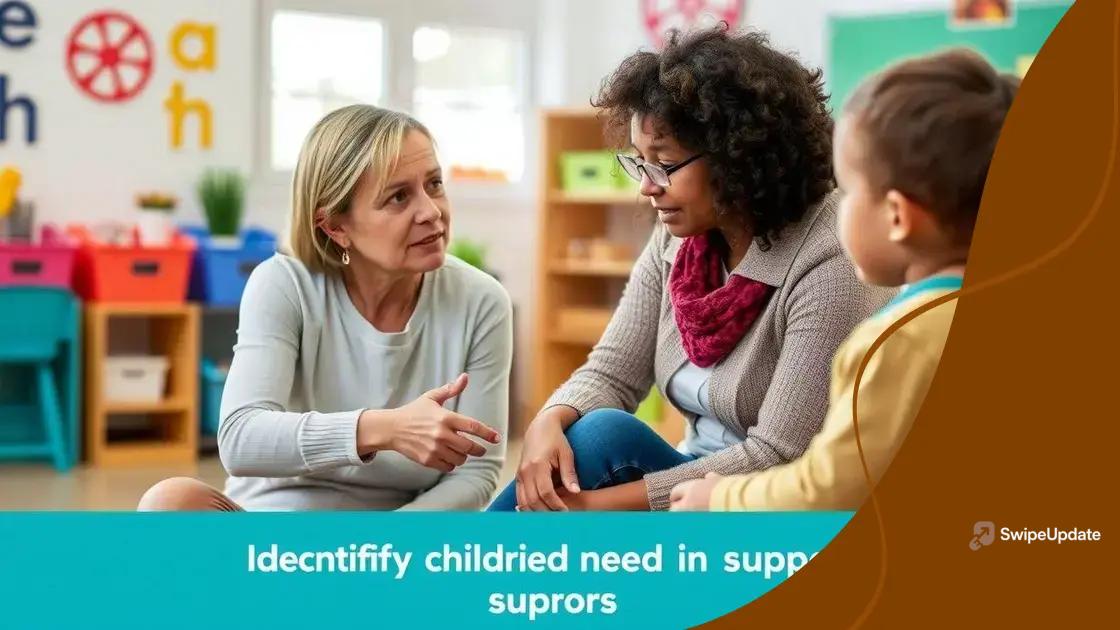The importance of early intervention in child development

The importance of early intervention is critical in addressing developmental delays in children, as it provides timely support and resources that significantly enhance their growth and future potential.
The importance of early intervention in child development cannot be overstated. It’s about recognizing challenges early and providing support that shapes a better future. Wondering how this can make a difference? Let’s explore together.
Understanding early intervention strategies
Understanding early intervention strategies is crucial for helping children reach their fullest potential. These strategies provide timely support to children who may be at risk for developmental challenges.
What are early intervention strategies?
Early intervention strategies can encompass a variety of approaches. Their main goal is to identify concerns as soon as possible and provide necessary resources and support. This can involve both educational and therapeutic services.
Key components of early intervention
There are several essential components involved:
- Assessment: Regular evaluations help identify children’s specific needs.
- Individualized plans: Tailored strategies focus on each child’s strengths and challenges.
- Family involvement: Engaging families ensures that support continues at home.
- Collaboration: Professionals from various fields work together to provide comprehensive care.
These components work hand in hand to make a difference in a child’s life. Understanding early intervention strategies means recognizing that every child benefits from support that caters to their unique needs.
For example, speech therapy can be vital for a child who is struggling to communicate effectively. On the other hand, occupational therapy can assist those who need help with daily activities. The key is to integrate these services seamlessly into the child’s daily routine.
As personalized strategies evolve, the importance of continuous assessment cannot be overstated. Regular follow-ups allow specialists to adjust the approaches based on the child’s progress.
The role of training and support
Educators and caregivers also benefit from training in these strategies. Understanding how to recognize signs of delay can enhance their ability to support children effectively. Workshops and resources can equip them with tools to promote developmental milestones.
When communities invest in early intervention strategies, they unlock potential not just for individual children, but for society as a whole. By prioritizing early support, we can pave the way for healthier futures.
Benefits of early intervention for children
The benefits of early intervention for children are profound and can influence a child’s future. By providing support early on, we can address developmental delays and promote healthy growth.
Improved developmental outcomes
Children who receive early intervention often show significant improvements in various areas, including:
- Cognitive skills: Helping children develop critical thinking and problem-solving abilities.
- Communication: Enhancing language skills that are vital for effective interaction.
- Social skills: Encouraging positive interactions with peers and caregivers.
- Emotional well-being: Supporting emotional regulation and resilience.
When children are supported during crucial developmental phases, they tend to flourish and reach their potential sooner. For instance, a child who struggles with speech may find their voice with targeted assistance, leading to greater confidence in social settings.
Enhancing family involvement
Another benefit of early intervention is the increased involvement of families in their child’s development. This process fosters a partnership where parents learn effective strategies to support their child at home. Such engagement creates a nurturing environment that reinforces what the child learns in therapy or educational settings.
Moreover, when families gain knowledge and skills from professionals, they feel empowered in their parenting roles. This can greatly reduce stress as they understand how to navigate challenges and celebrate milestones.
Access to early intervention programs also means that families can tap into community resources designed to assist them. These can range from workshops to support groups, helping families connect and share their experiences.
Cost-effectiveness
Investing in early intervention for children can lead to long-term savings. By addressing issues early, families may avoid more costly interventions later in life. Research has shown that children who receive these services are less likely to need special education services in school, which can be a significant expense. Thus, early intervention not only helps the child but also provides financial relief for families and communities.
In summary, the benefits of early intervention are extensive, covering emotional, social, and cognitive aspects while promoting family involvement. These advantages underline the need for timely and accessible resources to help every child succeed.
How to identify children in need of support

Knowing how to identify children in need of support is key for parents and educators alike. Early signs can signal the need for intervention, making awareness crucial in promoting healthy development.
Signs of developmental delays
There are specific indicators that can help adults recognize when a child may need additional support. These signs can vary across different developmental areas:
- Communication: If a child is not using appropriate words, gestures, or expressions for their age, it may be a concern.
- Social interactions: Limited engagement with peers or difficulties in making friends can suggest the need for help.
- Motor skills: Trouble with coordination or basic motor tasks could indicate developmental issues.
- Emotional responses: Extreme reactions to everyday situations can highlight emotional struggles.
Understanding these red flags is the first step. When you notice any of these signs, it can be helpful to observe the child over time to see if these behaviors persist or worsen.
Importance of regular assessments
Another practical approach is to schedule regular assessments with healthcare providers. Pediatricians and child psychologists can offer screening tests that evaluate a child’s development comprehensively. These assessments help in identifying any potential issues early on.
Additionally, some communities offer developmental screening programs which can be invaluable. Parents are encouraged to participate in these programs to stay informed about their child’s growth.
It’s important to remember that not all children develop at the same pace, so comparing them to peers can be misleading. However, if there is a consistent pattern of concern, it’s time to seek advice.
Engaging with educators
Collaboration with educators can also provide insights into a child’s behavior in a school setting. Teachers often have the experience to spot developmental concerns based on their observations. Building a strong partnership with educators can create a support network that helps children thrive.
In conclusion, the earlier you can spot signs of needed support, the better the chances of effective intervention. Being alert and proactive can greatly enhance a child’s developmental journey.
Practical steps for parents and caregivers
Taking practical steps for parents and caregivers is vital in supporting children’s development. Early intervention is most effective when parents are active participants in the process.
Establish a routine
Creating a structured routine can help children feel secure and thrive. Routines provide predictability and can help children understand what to expect throughout the day. Simple daily activities like reading together, meal times, and playtime can be highly beneficial.
Encourage communication
Parents and caregivers should encourage open communication with children. Ask questions, listen actively, and engage in conversations. This practice not only improves language skills but also builds self-esteem. You can:
- Use clear simple language: Tailor your language to the child’s level to promote understanding.
- Encourage storytelling: Ask children to express their thoughts and feelings through stories.
- Practice turn-taking: This helps develop social skills and enhances communication.
Regularly engaging with your child in conversation strengthens your bond and helps them feel valued.
Seek resources and support
Don’t hesitate to seek community resources that focus on child development. Local organizations or support groups can provide valuable information and assistance. Parents and caregivers can learn about workshops, seminars, or parenting classes that strengthen their skills.
Moreover, establishing a network of support can be vital. Connecting with other parents or caregivers can offer insights and encouragement. Sharing experiences helps build a community that fosters growth and learning.
Monitor progress and be proactive
Continuously observe your child’s progress. Documenting milestones or changes can provide insights into their development. If you notice any concerns, address them early by consulting professionals.
Additionally, being proactive includes advocating for your child’s needs in educational settings. Communicate with teachers to ensure they are aware of your child’s strengths and challenges.
Government and community resources available
Accessing government and community resources is essential for families seeking support for early intervention. These resources can provide vital services to help children develop and thrive.
Government programs
Many countries offer programs specifically designed to assist children in need. These programs can provide funding, assessments, and services aimed at early childhood development.
- Early Intervention Services: Available through local education agencies, these services often include therapy and educational support.
- Medicaid: In the U.S., Medicaid may cover necessary developmental evaluations and treatments for qualified children.
- Head Start: This federal program provides education, health, and nutrition services to low-income children and families.
Understanding and utilizing these government programs can make a significant difference in a child’s developmental journey.
Community organizations
In addition to government programs, many community organizations play a vital role in early intervention. They often offer workshops, support groups, and additional resources to families.
Local non-profits frequently provide services such as:
- Parent training sessions: Empowering parents with skills to support their child’s development.
- Social groups: Providing opportunities for children to interact with peers in a supportive environment.
- Assessment clinics: Offering access to developmental screenings by professionals.
Community resources can also connect families with others facing similar challenges, creating camaraderie and shared experiences.
Knowing where to find these resources is crucial for parents and caregivers. It’s recommended to reach out to local schools or pediatricians for referral information. Developing a partnership with these organizations can enhance support for the child and family.
FAQ – Frequently Asked Questions about Early Intervention and Child Development
What is early intervention?
Early intervention refers to services and support provided to young children who may be at risk for developmental delays, helping them develop crucial skills.
How can parents recognize if their child needs support?
Parents can look for signs such as difficulties in communication, social interactions, and motor skills to identify if their child may need assistance.
What resources are available for families seeking help?
Families can access various government programs and community organizations that offer services like assessments, therapy, and educational support.
Why is family involvement important in early intervention?
Active family involvement can enhance a child’s development by creating a supportive environment and ensuring that strategies are reinforced at home.
